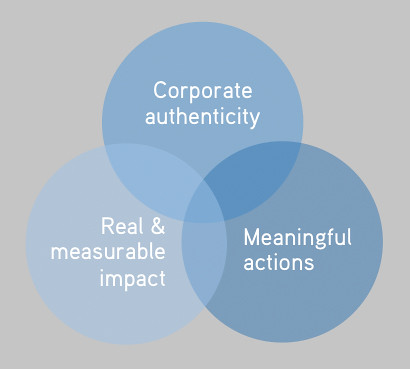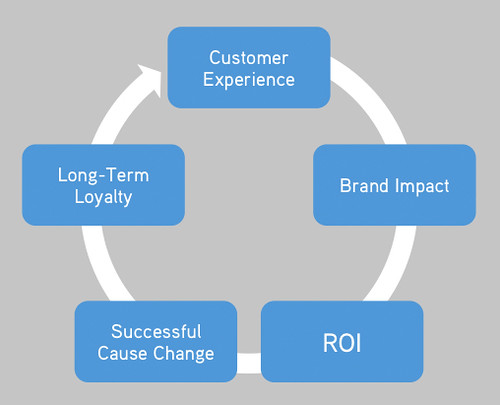Want to be Geoff Livingston‘s guest at the Cause Marketing Forum this May 30-31 in Chicago? The best comment wins a free registration worth $1,045.00 for a business or $795 for a nonprofit, compliments of Mightycause (also cross-posted on Geoff’s blog). A decision will be made tomorrow morning based on comments on both blogs.
Customers want brands to invest in marketing, that much is clear. There’s enough data out there that shows that people love brands that invest in their community’s general well being (skip ahead if you want to see the stats). Yet brands struggle weaving cause marketing and corporate social responsibility programs into the fabric of their marketing communications.
Some of the cause marketing problems facing corporate brands include:
1) Corporate social responsibility programs are company’s best kept secrets. They invest in communities, but don’t tell anyone about it. This leaves CSR to annual reports, dark corners of the About page on the web site, and a token press release. In the worst case scenarios, brands just don’t give a damn about their community.
2) Communicating CSR within the context with brand and product marketing challenges most companies. They know how to sell, but they struggle to develop communications that resonate on a larger level with their stakeholders about common societal issues. Resulting cause marketing efforts fall flat, lacking in the authenticity and meaning to succeed.

Optimized cause marketing demands more sophisticated communications than a simple percentage of profit allocated to a nonprofit.
3) Niche social media programs make CSR and cause marketing easier, yet most companies don’t take advantage of these tools. Consider that social provides a means to directly interact with customers who have already identified themselves as loyalists. Similarly, for some brands in-store communications provides another channel to communicate with customers.
4) Cause marketing often fails to go beyond broadcast communication to directly involve the stakeholder in real cause-based activity. Slacktivisim in the form of likes and reshares achieves a basic marketing purpose, but does not address long-term societal issues and meaningful actions for all parties. Measurable theories of change are not enacted.
Before I discuss my thinking on one part of the solution, here’s a recap of some the stats shared on Danny Brown’s site and one of my prior Inspiring Generosity posts:
- — 71% of consumers are giving as much (or more) as they were before the economy dipped (IAB).
- — 87% of consumers would switch brands to deal with companies associated with good causes (IAB).
- — 50% of consumers would pay more for brands associated with good causes (IAB).
- — 83% of Americans wish brands would support causes (AdAge).
- — 41% have bought a product because it was associated with a cause (AdAge).
These statistics show that every brand should seriously consider activating their willing customers in cause-based programs that enhance their user experience.
Crafting Cause Marketing Strategies

Cause marketing involves many eating together intricacies for brands.
Cause marketing communications represents perhaps the most complex form of brand communications because it blends so many elements. In addition to the difficulties listed above, there are the continuing challenges of multichannel integration in general communications, the need to deliver ROI with any communications, the complexity of weaving cause-based activity into an overarching brand message, and finally working with a cause to develop a meaningful program that will actually achieve something.
These sophisticated intricacies make crafting cause-based marketing and public CSR programs that much more difficult. That’s why the community development work Starbucks supports publicly, in contests, in ads, and at every one of its stores really impresses me. Starbucks embraces CSR and its sister cause marketing as part of its very fiber.
But for every Starbucks, there are 99 companies that perform at a lesser level. Most marketers don’t even know where to begin. To me, that’s the real issue.
Frameworks, best practices, and methods need to be better communicated to achieve better communications programs. As always it starts with objectives. Those objectives need to include traditional ROI and marketing outcomes, as well as KPIs for customers satisfaction with the program, and social good impact. One of the things I am working on a is a methodology to build cause marketing programs that are mapped from the user perspective.
Some questions that need to be answered by each brand:
- — What does the brand want to achieve, business wise and for its community?
- — When is the right time to introduce conversations about the cause-based activity?
- — What are the points of contact?
- — How can they engage?
- — Will the actions provide paths for customers to achieve a sense of personal fulfillment?
- — How will those actions create a better bond between brand and person?
- — What is the long term impact of the program?
What do you think? Why you do brands struggle with their cause based initiatives?
